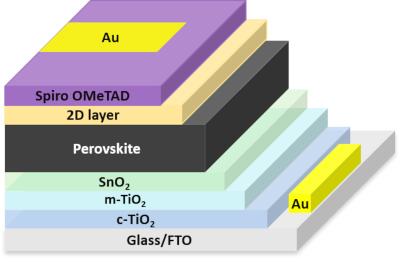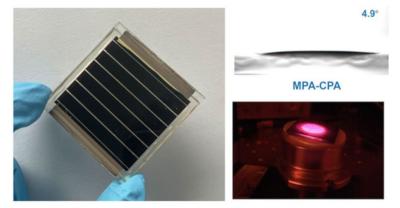Perovskite-Info weekly newsletter
Published: Tue, 05/02/23
The Perovskite-Info newsletter (May 2, 2023)
Cannot read this? View it online here
Researchers develop an additive to enhance the stability of perovskite/silicon tandems
Researchers at the Ningbo Institute of Materials Technology and Engineering (NIMTE) of the Chinese Academy of Sciences (CAS), University of Macau and Celanese (China) Holding have developed a long-alkyl- chain anionic surfactant (LAS) additive that can significantly improve the long-term operational stability of perovskite/silicon tandem solar cells.
Traditional methods to improve the stability of perovskite solar cells include encapsulation, crystallization engineering, and defect passivation. Similar to “stress corrosion” in metals, glass and polymers, subcritical perovskite deterioration inevitably occurs due to tensile stress during the fabrication and operation, which degrades device performance. To suppress the “stress corrosion”, the researchers developed the novel LAS additive for the perovskite/silicon tandem solar cells.
Researchers develop 3D/2D perovskite solar cell with 23.08% efficiency thanks to PEAI salt
An international research team that includes scientists from EPFL in Switzerland, Middle East Technical University (METU) in Turkey, Lomonosov Moscow State University in Russia and The University of Tokyo has fabricated a quasi-2D perovskite solar cell with a unique type of salt to enhance hole extraction.
The triple-cation perovskite absorber was treated with phenethylammonium iodide (PEAI), a modulator that alters the perovskite film's surface energy and forms a quasi-2D structure without further annealing. The result is a 23.08%-efficient device that is also able to retain 95% of its initial efficiency after 900 hours.
Ascent Solar Technologies announces $5 million financing agreement with BD1 Holdings
U.S-based PV company, Ascent Solar Technologies (ASTI), has announced that it has entered into a USD $5 million debt financing agreement with BD1 Investment Holdings, a substantial existing stockholder of the Company. The Company will receive the monies in four monthly installments. The first tranche (for $2 million) will close in mid-May 2023. Three subsequent tranches (each for $1 million) will close in mid-June, mid-July, and mid-August 2023. The proceeds of the investment will be used for general business operations and working capital for future initiatives.
This commitment from BD1 Holdings arrives as the Company accelerates a strategic plan that includes global expansion, new revenue streams and progress in perovskites solar technology. This announcement is preceded by a series of announcements including a 300% increase in modern manufacturing capacity at a new location in Switzerland, a new $9M round of equity financing, and the inauguration of a new Center of Excellence focused on Perovskites commercialization.
Researchers focus on stabilization of photoactive phases to improve perovskite photovoltaics
Researchers from the University of Surrey, University of Toronto, University of Stuttgart and Ulsan National Institute of Science and Technology have found that stabilizing the perovskite "photoactive phases" – the specific part of the material that is responsible for converting light energy into electrical energy – is the key step towards extending the lifespan of perovskite solar cells. The stability of the photoactive phase is important because if it degrades or breaks down over time, the solar cell will not be able to generate electricity efficiently. Therefore, stabilizing the photoactive phase is a critical step in improving the longevity and effectiveness of perovskite solar cells.
In the study, the team assessed the current understanding of these phase instabilities and summarized the approaches for stabilizing the desired phases, covering aspects from fundamental research to device engineering. The scientists subsequently analyzed the remaining challenges for perovskite PVs and demonstrated the opportunities to enhance phase stability with ongoing materials discovery and in operando analysis. Finally, the team proposed future directions towards upscaling perovskite modules, multijunction PVs and other potential applications.
Researchers develop efficient inverted perovskite solar cells using a novel molecular hole-transporter
Researchers from East China University of Science and Technology, Jilin University, Huazhong University of Science and Technology, ShanghaiTech University, Chinese Academy of Sciences, Shanghai Jiao Tong University and University of Potsdam have found that a new molecular hole-transporter can improve the performance of inverted perovskite solar cells and mini modules.
Left: mini module. Upper right: contact angle of the perovskite solution on the self assembled monolayer. Lower right: PL emission of a perovskite film. Image from University of Potsdam website.
Inverted perovskite solar cells are seen as particularly promising thanks to their simple fabrication at low costs and their relative stability. Inverted perovskite solar cells resemble organic solar cells, with a layer of perovskite replacing the organic absorber layer. In the recent study, the authors developed a novel hole transport layer based on a self-assembled monolayer. This monolayer consists of amphiphilic molecules, molecules that are both hydrophilic (water-soluble) and hydrophobic (water-fearing).
Metalgrass LTD
9 Har Tsin St.
Kfar Sava Hasharon 4430809
ISRAEL
Unsubscribe | Change Subscriber Options







